#application programming interface management
Explore tagged Tumblr posts
Text
Best Practices for Scalable and Secure API Services in Application Programming Interface Management
In today’s fast-paced digital ecosystem, businesses across industries are increasingly turning to Application Programming Interfaces (APIs) to build more efficient, scalable, and secure systems. APIs facilitate seamless integration between different platforms, helping companies automate processes, share data, and enhance user experiences. For industries like ad film production stages, advertising film making, and film and photography company ads, managing API services effectively is crucial to ensure smooth workflows and protect sensitive information.
However, managing APIs comes with its challenges—especially when it comes to scalability and security. As the demand for real-time communication and data exchange grows, businesses must ensure that their API services are both scalable and secure. This blog delves into the best practices for API management, focusing on scalability and security, and how these practices can help businesses in industries such as film production thrive.
1. Designing APIs for Scalability
Scalability is one of the most important factors in application programming interface management. As businesses grow, so does the volume of data and the number of API requests. APIs must be designed to handle high traffic and increasing demand without compromising performance. Here are key strategies for building scalable APIs:
a. Use of RESTful API Design Principles
REST (Representational State Transfer) is a popular architectural style for designing APIs. By adhering to RESTful principles—such as statelessness, cacheability, and a uniform interface—APIs become easier to scale. RESTful APIs are lightweight and flexible, which makes them ideal for handling large volumes of requests, a common scenario in industries like advertising film making, where multiple collaborators—directors, producers, clients, and agencies—are working on the same project.
For ad film production stages, RESTful APIs can help integrate various tools such as project management software, video editing tools, and client communication platforms, ensuring smooth communication and data exchange. With RESTful design, each component can scale independently, which is crucial as the demands on the system increase over time.
b. Leverage Caching for Performance
Caching frequently accessed data can drastically improve the performance of your API and reduce server load. By caching responses for common queries, businesses can minimize the number of requests to the server, reducing latency and ensuring that users experience faster response times.
For example, a film and photography company ads might use caching to quickly retrieve frequently accessed content, such as media assets, client approvals, or project timelines, without overloading the system with repeated requests. This not only improves the user experience but also ensures that resources are used efficiently.
c. Load Balancing
Load balancing is another essential practice for scalability. It distributes incoming traffic across multiple servers to prevent any single server from being overwhelmed. This technique ensures high availability and reliability, especially during peak times or when there are spikes in API usage.
In ad film production stages, where different departments (e.g., creative, production, post-production) may simultaneously require access to media files or project updates, load balancing ensures that the system can handle this increased demand efficiently, providing uninterrupted service to all users.
2. Ensuring API Security
As the digital landscape evolves, ensuring the security of your API services has become paramount. APIs often act as gateways to sensitive data and business-critical services. To protect against cyberattacks and data breaches, businesses must adopt robust security measures. Below are key security best practices:
a. Authentication and Authorization
Implementing strong authentication and authorization protocols is the first step in securing your APIs. OAuth 2.0 is one of the most commonly used protocols for secure authorization, as it allows third-party applications to access user data without exposing login credentials.
For advertising film making companies collaborating with external vendors or agencies, OAuth 2.0 ensures that only authorized users can access certain assets, such as scripts, footage, or client contracts. It provides a secure and flexible mechanism for managing access control, which is essential when dealing with sensitive information.
b. Use of HTTPS (TLS Encryption)
APIs should always be accessed over HTTPS (Hypertext Transfer Protocol Secure) to ensure that data is encrypted during transmission. HTTPS, which relies on Transport Layer Security (TLS), encrypts communication between the client and the server, preventing malicious actors from intercepting or tampering with the data.
For businesses involved in film and photography company ads, protecting sensitive client data—whether it's images, contracts, or project details—is critical. By using HTTPS, companies ensure that all data exchanged through the API remains encrypted, adding an extra layer of protection against cyber threats.
c. Rate Limiting
Rate limiting helps prevent abuse of your API by limiting the number of requests a user or system can make within a specified time period. This prevents Distributed Denial of Service (DDoS) attacks and ensures that the API can handle traffic without being overwhelmed.
In ad film production stages, multiple users from different departments and locations might simultaneously make requests for resources such as media files or status updates. Implementing rate limiting ensures that no single user or system monopolizes the API, allowing for a fair distribution of resources and improved reliability for all users.
d. API Key Management
Using API keys is another way to secure your API services. API keys are unique identifiers that authenticate users and monitor API usage. By assigning specific keys to different teams or clients, businesses can track who is accessing the API and control their level of access.
For advertising film making businesses, API key management allows them to restrict access to sensitive production data, such as client files or intellectual property, to authorized personnel only. This ensures that only relevant team members, vendors, or collaborators can access specific resources.
3. API Versioning for Flexibility
As businesses grow and their needs evolve, APIs must be able to accommodate changes without disrupting existing services. API versioning is an important strategy to ensure backward compatibility while allowing for the introduction of new features and functionality.
In film and photography company ads, different departments may need to work with different versions of the same API as they adopt new technologies or workflows. By implementing a versioning strategy—such as including version numbers in the API URL (e.g., /v1, /v2)—businesses can ensure that new versions of the API don’t break existing integrations. This gives teams the flexibility to adopt new features without interrupting ongoing projects or workflows.
4. Monitoring and Logging
Monitoring and logging API usage is crucial for identifying performance issues, security threats, or potential bottlenecks in the system. By actively tracking API requests, businesses can gain valuable insights into user behavior, identify areas for improvement, and proactively address potential problems.
For ad film production stages, real-time monitoring helps ensure that teams have constant access to the tools and data they need, minimizing disruptions. Logging also provides an audit trail, which is essential for tracking and addressing any security breaches or unauthorized access attempts.
5. Documentation and Developer Support
Clear and comprehensive API documentation is key to ensuring that internal teams, as well as external developers, can use and integrate the API effectively. Good documentation helps developers understand how the API works, what endpoints are available, and how to troubleshoot any issues.
For advertising film making companies working with external collaborators or agencies, providing well-documented APIs ensures that integration with third-party tools—such as video editing software or project management platforms—is smooth. Clear documentation minimizes confusion, speeds up integration, and enhances overall productivity.
Conclusion
As businesses continue to rely on application programming interface management to streamline workflows, enhance collaboration, and integrate services, it is critical to adopt best practices for scalability and security. Designing APIs for scalability, ensuring robust security measures, implementing versioning strategies, and maintaining comprehensive monitoring and documentation will help businesses in industries like ad film production stages, advertising film making, and film and photography company ads thrive in the digital age.
By prioritizing scalability and security, businesses can create APIs that are not only efficient and flexible but also secure and resilient, empowering them to meet future challenges and seize new opportunities. With the right approach to API management, companies can ensure their systems are built to scale, protect sensitive data, and maintain seamless collaboration across teams and third-party platforms
0 notes
Text
API-First Development: Revolutionizing Digital Integration and Scalability

Explore how API-first development is transforming digital integration and scalability. Learn how this approach streamlines development, enhances flexibility, and enables seamless communication between systems, driving innovation and growth in modern applications. Visit now to read more: API-First Development: Revolutionizing Digital Integration and Scalability
#agile development#api management#api strategy#api-first development#application programming interfaces#digital integration#digital transformation#microservices architecture#reusable apis#scalable software#software delivery velocity
0 notes
Text

Technology plays a vital role in everyone’s daily lives, from the simplest forms of applications to the most creative inventions. Every application or software has been built by a web developer. In these present days, students and youngsters want to be web developers to make their careers way better.
#Web Development#Remote Work in Web Development#Web Development Certifications#Interview Tips for Web Developers#Salary Expectations in Web Development#Job Satisfaction in Web Development#Future of Web Development#Content Management Systems (CMS)#Website Optimization#Cross-browser Compatibility#Mobile Development#Web Security#APIs (Application Programming Interfaces)
0 notes
Text
maestro’s muse 💿 applications open!
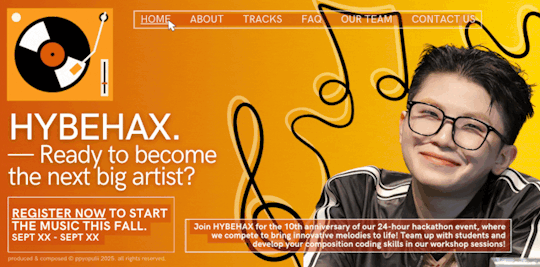
PREVIEW. The show’s about to start… are you ready to be in charge of the music? Apply now to become an organizer for HYBE University’s 10th annual hackathon! 🎶
FEATURING. lee jihoon x gn!reader, various non-idol!hybe groups & reader GENRE(S). coming of age, fluff, some angst EXPLICITS. none!
JAY’S MUSINGS. prologue (part one) for maestro’s muse, the series. this one is relatively short (think of it as a teaser, almost), but part two should be up in a few days! enjoy :)

www.hybehax.tech/apply
⏳ Loading Application…

HYBEHAX is a 24-hour collegiate level hackathon where hackers come together at HYBE University to compete and bring innovation to life. This year, our theme specializes in music and creating a festival everyone can enjoy. Interested in working the event? Fill out the questionnaire below and our team will reach out to you once the application period has ended.
SECTION ONE — General Application
* Indicates a required field.
What year of college are you going to be for the upcoming school year?*
◻️ Freshman/First-Year
☑️ Sophomore/Second-Year
◻️ Junior/Third-Year
◻️ Senior/Fourth-Year
◻️ Other (please specify):
What teams would you be interested in applying for?*
Note: You are allowed to pick more than one team, but should you be asked to interview with us, you will only end up placed on one team.
◻️ Marketing Team (handles social media content and outreach)
◻️ Sponsorship Team (specializes in securing and managing POCs with sponsoring companies)
◻️ Tech Team (manages the digital infrastructure of our hackathon, such as the websites/forms/app)
☑️ Design Team (works on merchandise and various designs for social media, sponsors and digital platforms)
Would you be interested in a leadership position, i.e. Team Lead?*
Team Leads delegate specific tasks to members and collaborate with other Leads/E-board to ensure preparations are properly managed in a timely manner.
☑️ Yes, I’d be interested!
◻️ No, I’d like to only contribute as a HYBEHAX organizer.
Tell us a little about yourself!*
What’s your story? What drew you to want to become an organizer for HYBEHAX? 200 words max.
Hello! As a rising sophomore and current freshman, I could only be a volunteer for this past hackathon season. However, the energy I was met with was like no other; I had never before seen so many wonderful people bond together in a space to share, create, and be known for their accomplishments. I found myself inspired by the passion the hackers embodied and want to work towards creating a similar space this year, especially in light of it being the 10th year anniversary. I hope to bring that same energy and creativity to the table as an organizer! Thank you for this opportunity!
-> Next Section
SECTION TWO — Design Team Application
* Indicates a required field.
Which of the following design programs do you have experience with?*
Check all that apply.
☑️ Adobe Illustrator
☑️ Adobe Photoshop
☑️ Canva
☑️ Figma
☑️ Others (fill out as you see fit): also have experience in procreate, as well as designing stickers with brandmaker & t-shirts/hoodies specifically with custom-ink!
What made you apply for Design Team?*
200 words max.
As a computer science major who has a hobby for all things artistic, I’ve always been interested in the intersection of the two. I believe that integrating technology and the arts is crucial for navigating our ever-changing world. I love using what I know about computer science to further my passion for art, such as messing around with designing UI/UX interfaces for applications and then coding them up. I think it’s fun :)
(OPTIONAL) Portfolio Upload
📎 www.lyrart.com/home
(OPTIONAL) Resume Upload
📎 resume20XX.pdf
-> Submit Application
⏳ Submitting…
Thank you for applying to be a HYBEHAX organizer! Our team will reach out to you soon after the application period ends with results.

#seventeen#lee jihoon x reader#woozi x reader#seventeen x reader#seventeen fluff#seventeen imagines#lee jihoon imagines#lee jihoon fluff#woozi fluff#woozi imagines#🏆 hybehax#maestro’s muse 💿 ljh#🎶 ppyopulii’s discography
38 notes
·
View notes
Text
okay whenever i talk about linux i say shit like "development is easier" or throw around things like LXC or POSIX/UNIX, or whatever insane terms but:
here's my list of actual shit that the average person would care about
Most updates including core system components usually don't even need a reboot(please reboot your computer at least once a week). If it does, it waits for me to reboot. It wont ever stop me in the middle of something to ask me to or force it on me.
If i plug in a device it will just work. I do not need to install drivers or some stinky special crap software for it to be detected, it will most often just work (every new linux kernel version adds so much support for new and old hardware. If it doesn't work now, it might work later!)
Package management. I've sung it's praises so much already but. every other device i know you can click a button and it will update all the apps on your device. except windows. App has an update? Open the software centre or Discover or whatever, click a button boom it's updated. All controlled from one place, no worries about does the app update itself, or whether you're downloading the right installer for your system, just use the package manager that comes with the system and it's good.
It's as minimal as i want it to be. Both windows and mac suffer a lot from just having a bunch of crap that you cannot get rid of. I installed a distro which didnt even come with a graphical interface, it was that minimal. If the distro you use is a bit more reasonable, but it comes with some software you dont want, you can just get rid of it. Shit if you wanted to you can just uninstall the linux kernel and it will just let you, and your computer will be unbootable. You have full control over what you want on your system. Also uninstalling things is less stupid, there's much less cases of leftover files or shit laying around in the registry. (there is no registry)
Audio. "linux audio is bad" is a thing of the past and i'm so serious. Pipewire is an amazing thing. I have full control over which applications give output to which speakers, being able to route one app to multiple speakers at the same time, or even doing things like mapping an input device to speakers so i can monitor it back very easily. I still dont understand why windows does the stupid "default communication device" thing, and they often reset my settings like randomly changing it to 24 bit audio when i only use 16 and certain programs break with it set to 24 idfk. Maybe this is less of an "average user" thing and more of a poweruser thing but i feel like there's SOMETHING in here which may be handy to the average person at some point. i love qpwgraph.
i could think of more but i dont use a computer like a normal person so it will take me time to think of it
14 notes
·
View notes
Text
Elon Musk’s so-called Department of Government Efficiency (DOGE) has plans to stage a “hackathon” next week in Washington, DC. The goal is to create a single “mega API”—a bridge that lets software systems talk to one another—for accessing IRS data, sources tell WIRED. The agency is expected to partner with a third-party vendor to manage certain aspects of the data project. Palantir, a software company cofounded by billionaire and Musk associate Peter Thiel, has been brought up consistently by DOGE representatives as a possible candidate, sources tell WIRED.
Two top DOGE operatives at the IRS, Sam Corcos and Gavin Kliger, are helping to orchestrate the hackathon, sources tell WIRED. Corcos is a health-tech CEO with ties to Musk’s SpaceX. Kliger attended UC Berkeley until 2020 and worked at the AI company Databricks before joining DOGE as a special adviser to the director at the Office of Personnel Management (OPM). Corcos is also a special adviser to Treasury Secretary Scott Bessent.
Since joining Musk’s DOGE, Corcos has told IRS workers that he wants to pause all engineering work and cancel current attempts to modernize the agency’s systems, according to sources with direct knowledge who spoke with WIRED. He has also spoken about some aspects of these cuts publicly: "We've so far stopped work and cut about $1.5 billion from the modernization budget. Mostly projects that were going to continue to put us down the death spiral of complexity in our code base," Corcos told Laura Ingraham on Fox News in March.
Corcos has discussed plans for DOGE to build “one new API to rule them all,” making IRS data more easily accessible for cloud platforms, sources say. APIs, or application programming interfaces, enable different applications to exchange data, and could be used to move IRS data into the cloud. The cloud platform could become the “read center of all IRS systems,” a source with direct knowledge tells WIRED, meaning anyone with access could view and possibly manipulate all IRS data in one place.
Over the last few weeks, DOGE has requested the names of the IRS’s best engineers from agency staffers. Next week, DOGE and IRS leadership are expected to host dozens of engineers in DC so they can begin “ripping up the old systems” and building the API, an IRS engineering source tells WIRED. The goal is to have this task completed within 30 days. Sources say there have been multiple discussions about involving third-party cloud and software providers like Palantir in the implementation.
Corcos and DOGE indicated to IRS employees that they intended to first apply the API to the agency’s mainframes and then move on to every other internal system. Initiating a plan like this would likely touch all data within the IRS, including taxpayer names, addresses, social security numbers, as well as tax return and employment data. Currently, the IRS runs on dozens of disparate systems housed in on-premises data centers and in the cloud that are purposefully compartmentalized. Accessing these systems requires special permissions and workers are typically only granted access on a need-to-know basis.
A “mega API” could potentially allow someone with access to export all IRS data to the systems of their choosing, including private entities. If that person also had access to other interoperable datasets at separate government agencies, they could compare them against IRS data for their own purposes.
“Schematizing this data and understanding it would take years,” an IRS source tells WIRED. “Just even thinking through the data would take a long time, because these people have no experience, not only in government, but in the IRS or with taxes or anything else.” (“There is a lot of stuff that I don't know that I am learning now,” Corcos tells Ingraham in the Fox interview. “I know a lot about software systems, that's why I was brought in.")
These systems have all gone through a tedious approval process to ensure the security of taxpayer data. Whatever may replace them would likely still need to be properly vetted, sources tell WIRED.
"It's basically an open door controlled by Musk for all American's most sensitive information with none of the rules that normally secure that data," an IRS worker alleges to WIRED.
The data consolidation effort aligns with President Donald Trump’s executive order from March 20, which directed agencies to eliminate information silos. While the order was purportedly aimed at fighting fraud and waste, it also could threaten privacy by consolidating personal data housed on different systems into a central repository, WIRED previously reported.
In a statement provided to WIRED on Saturday, a Treasury spokesperson said the department “is pleased to have gathered a team of long-time IRS engineers who have been identified as the most talented technical personnel. Through this coalition, they will streamline IRS systems to create the most efficient service for the American taxpayer. This week the team will be participating in the IRS Roadmapping Kickoff, a seminar of various strategy sessions, as they work diligently to create efficient systems. This new leadership and direction will maximize their capabilities and serve as the tech-enabled force multiplier that the IRS has needed for decades.”
Palantir, Sam Corcos, and Gavin Kliger did not immediately respond to requests for comment.
In February, a memo was drafted to provide Kliger with access to personal taxpayer data at the IRS, The Washington Post reported. Kliger was ultimately provided read-only access to anonymized tax data, similar to what academics use for research. Weeks later, Corcos arrived, demanding detailed taxpayer and vendor information as a means of combating fraud, according to the Post.
“The IRS has some pretty legacy infrastructure. It's actually very similar to what banks have been using. It's old mainframes running COBOL and Assembly and the challenge has been, how do we migrate that to a modern system?” Corcos told Ingraham in the same Fox News interview. Corcos said he plans to continue his work at IRS for a total of six months.
DOGE has already slashed and burned modernization projects at other agencies, replacing them with smaller teams and tighter timelines. At the Social Security Administration, DOGE representatives are planning to move all of the agency’s data off of legacy programming languages like COBOL and into something like Java, WIRED reported last week.
Last Friday, DOGE suddenly placed around 50 IRS technologists on administrative leave. On Thursday, even more technologists were cut, including the director of cybersecurity architecture and implementation, deputy chief information security officer, and acting director of security risk management. IRS’s chief technology officer, Kaschit Pandya, is one of the few technology officials left at the agency, sources say.
DOGE originally expected the API project to take a year, multiple IRS sources say, but that timeline has shortened dramatically down to a few weeks. “That is not only not technically possible, that's also not a reasonable idea, that will cripple the IRS,” an IRS employee source tells WIRED. “It will also potentially endanger filing season next year, because obviously all these other systems they’re pulling people away from are important.”
(Corcos also made it clear to IRS employees that he wanted to kill the agency’s Direct File program, the IRS’s recently released free tax-filing service.)
DOGE’s focus on obtaining and moving sensitive IRS data to a central viewing platform has spooked privacy and civil liberties experts.
“It’s hard to imagine more sensitive data than the financial information the IRS holds,” Evan Greer, director of Fight for the Future, a digital civil rights organization, tells WIRED.
Palantir received the highest FedRAMP approval this past December for its entire product suite, including Palantir Federal Cloud Service (PFCS) which provides a cloud environment for federal agencies to implement the company’s software platforms, like Gotham and Foundry. FedRAMP stands for Federal Risk and Authorization Management Program and assesses cloud products for security risks before governmental use.
“We love disruption and whatever is good for America will be good for Americans and very good for Palantir,” Palantir CEO Alex Karp said in a February earnings call. “Disruption at the end of the day exposes things that aren't working. There will be ups and downs. This is a revolution, some people are going to get their heads cut off.”
15 notes
·
View notes
Text
Why RDIAS Stands Out Among Top MBA Colleges in Delhi for Career-Driven Students
One of the most important choices for any student hoping to build a successful management career is selecting the best MBA colleges in Delhi. Before applying to MBA colleges in Delhi, students must consider several things due to the increasing competition and the need for workforce-ready professionals. Placement guarantee, academic freedom, and overall growth prospects are essential components that go beyond rankings and prices. The perfect MBA program should provide a holistic environment where students can excel academically and participate in extracurricular activities to develop their interpersonal and leadership abilities. A student’s path is led through value-added programs, consistent corporate exposure, and a strong placement cell. RDIAS (Rukmini Devi Institute of Advanced Studies), one of the best MBA colleges in Delhi, stands as a premier establishment that combines academic brilliance with practical application. Approved by AICTE and affiliated with GGSIPU, RDIAS is renowned for its strong industry interface, flexible atmosphere that fosters both professional and personal growth, and stable placement rates.

11 notes
·
View notes
Text
I’ve been thinking about this for a little while — something I’d want to do if I had the time and money would be to design a Motorola 68000-powered tiny (10” or smaller) laptop. Modern CMOS 68K implementations are very power-efficient and decently well-suited to handheld and portable devices (see: TI-92 series), and if combined with a crisp, modern monochrome OLED display, could get you days of continuous usage without needing a recharge! Add a few megabytes of RAM, some peripherals (IDE/CF controller, ISA or S-100 slots, DMA controller, SPI bus, RS-232 port, SD or CF slot, PS/2 port for a mouse, text mode + hires monochrome video card, etc…), and you have a nice, flexible system that can be rarely charged, doesn’t require ventilation, and can be just thick enough to fit the widest port or slot on it.
The main issue would be software support: nearly all existing operating systems that ran on a 68K were either intended for very specific hardware (Classic Mac OS, AmigaOS) or required more than a flat 68000 (NetBSD, Linux, or any other UNIX requiring MMU paging). So, it would probably end up being a custom DOS with some multitasking and priv level capability, or perhaps CP/M-68K (but I don’t know how much software was ever written for that — also, it provides a “bare minimum” hardware abstraction of a text-mode console and disk drive). A custom DOS, with a nice, standard C library capable of running compiled software, would probably be the way to go.
The software question perhaps raises another, harder question: What would I use this for? Programming? Then I’d want a text editor, maybe vi(m) or something like that. OK. Vim just needs termcap/(n)curses or whatever to draw the text, and not much else. That’s doable! You’d just need to provide text-mode VT100 emulation and termcap/curses should “just work” without too much issue. I like writing C, so I’d need a compiler. Now, I’m assuming this simplistic operating system would be entirely written in a combination of assembly language (to talk to hardware and handle specific tasks such as switching processes and privilege management and whatnot) and C (to handle most of the logic and ABI). I could probably cross-compile GCC and be good to go, aside from handling library paths and executable formats that don’t comply with POSIX (I have no intention of making yet another UNIX-like system). Hopefully, most other command-line software (that I actually use) will follow suit without too much trouble. I don’t know how much work it is to get Python or Lua to a new platform (though NetBSD on the 68K already supports both), but Python (or Lua) support would bring a lot of flexibility to the platform. Despite me being a Python hater, I must admit it’s quite an attractive addition.
What about graphics? All the software I’ve mentioned so far is text-mode only, yet historical 68K-based systems like the Mac and Amiga had beautiful graphics! Implementing X11 would be a massive pain in the ass, considering how much it relies on UNIXy features like sockets (not to mention the memory usage), and I really don’t want Wayland to have anything to do with this. I guess I’d have to roll my own graphics stack and window manager to support a WIMP interface. I could copy Apple’s homework there: they also made a monochrome graphics interface for a M68K configured with a handful of MiB of RAM. I could probably get a simple compositing window manager (perhaps make it tiling for a modern vibe ;3). Overall, outside of very simple and custom applications, functionality with real software would be problematic. Is that a big problem? Maybe I want an underpowered notebook I can put ideas and simple scripts down on, then flesh them out more fully later on. An operating system allowing more direct access to the hardware, plus direct framebuffer access, could yield some pretty cool graphing/basic design utility.
I’d need a way to communicate with the outside world. An RS-232 UART interface, similar to the HP-48 calculator (or the TI-92’s GraphLink, only less proprietary) would help for providing a remote machine language monitor in the early stages, and a real link to a more powerful (and networked) machine later on. I think real networking would defeat the purpose of the machine — to provide a way to remove yourself from modern technology and hardware, while retaining portability, reliability, and efficiency of modern semiconductor manufacturing techniques. Giving it a CF or SD slot could provide a nice way to move files around between it and a computer, maybe providing software patches. A floppy drive would be amazing: it would provide a way to store code and text, and would be just about the right storage size for what I want to do. Unfortunately, there’s not really a good way to maintain the size of the laptop while sticking a 3.5” (or worse, 5.25”) floppy drive in the middle of it. To my knowledge, 3.5” floppy drives never got thin enough to properly fit with all the other expansion slots, socketed components, and user-modifiable parts I’d want. A completely solid-state design would likely be the best option.
Anyway, uhh… I hope this made some semblance of sense and I don’t sound insane for going on a rant about building a modern computer with a 1979 CPU.
5 notes
·
View notes
Text
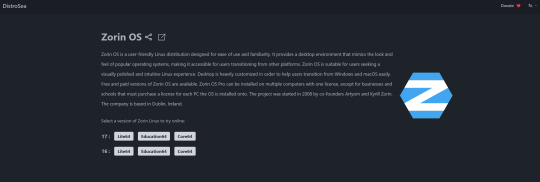
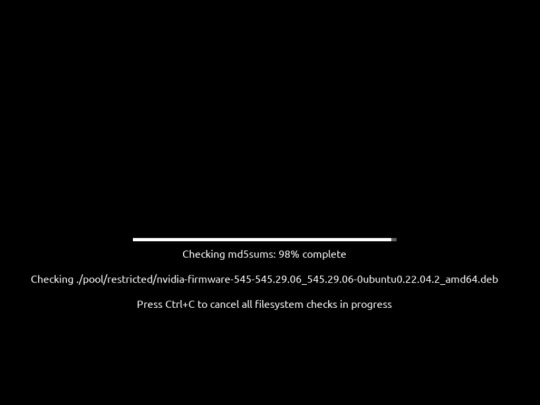
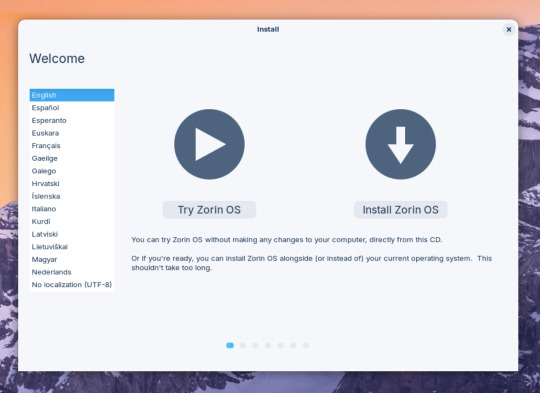

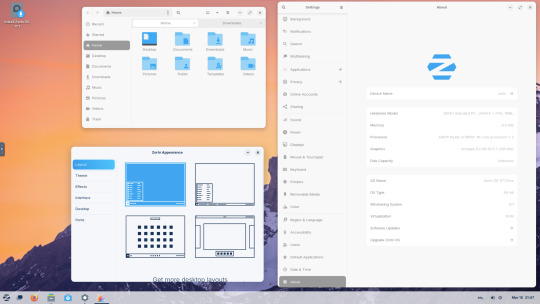


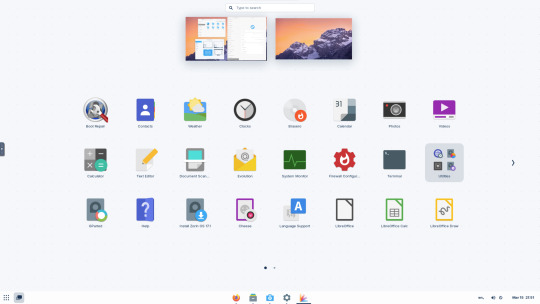
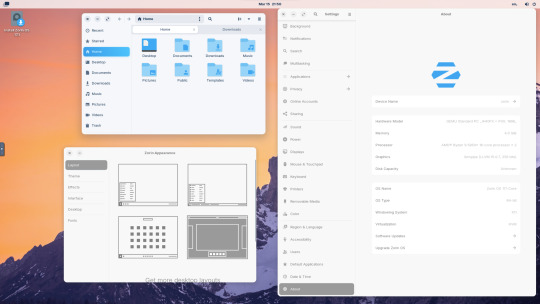
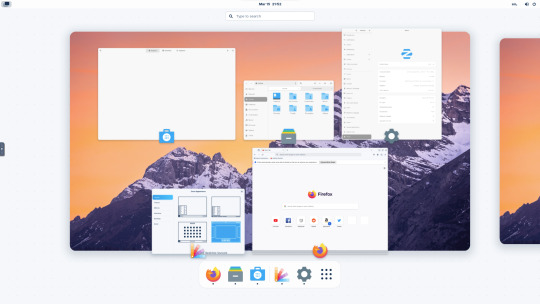

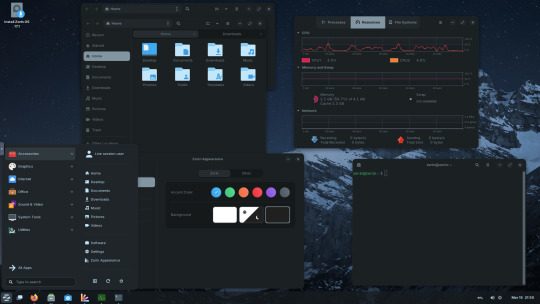


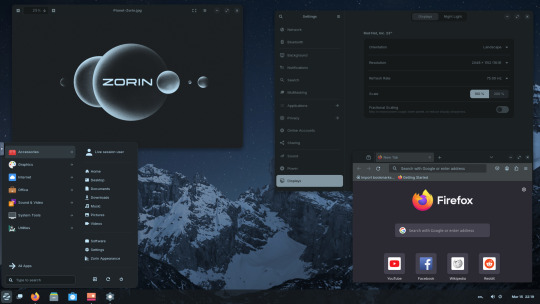
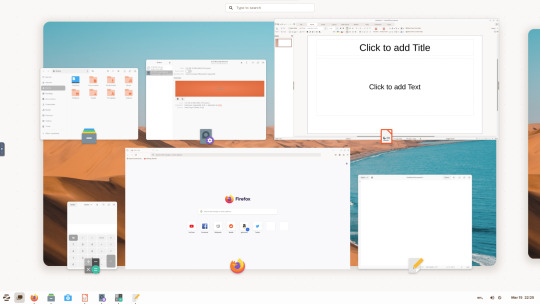
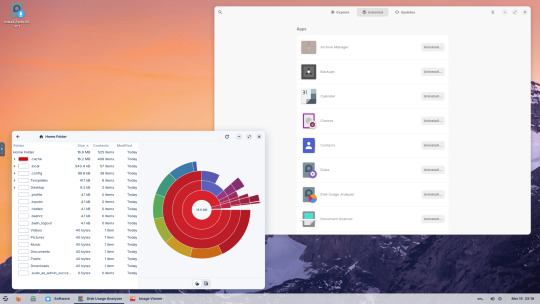
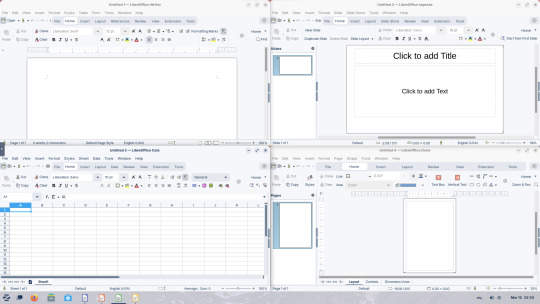
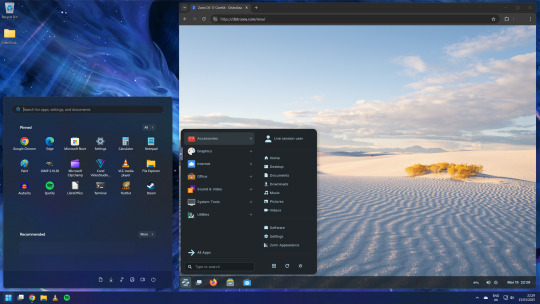

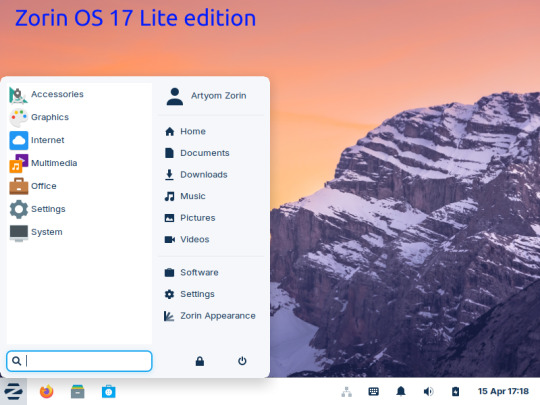
15.03.25
I tried out Zorin OS Linux on Distrosea.
https://distrosea.com/
Zorin OS started its development in 2008 by co-founders Artyom and Kyrill Zorin. The company is based in Dublin, Ireland.
Main site:
https://zorin.com/os/
Wiki link:
https://en.wikipedia.org/wiki/Zorin_OS
Like Linux Mint, it is based on Ubuntu, which in turn is based on Debian and uses the current Ubuntu 24.04.2 LTS base release.
It features the GNOME 3 and XFCE desktop environments and is available in Lite, Education and Core editions.
Due to enhanced performance optimizations in the Core, Pro, and Education editions of Zorin OS, the Lite version is being discontinued.
However the XFCE desktop packages will still be available through the official software repositories:
https://help.zorin.com/docs/getting-started/getting-zorin-os-lite/
I chose version 17 and selected the 'Core' edition.
This version (Core64) features the GNOME desktop and a few more apps. I clicked 'Try' when the Linux distro booted up to the install wizard. The distro performs a md5 sum check before boot-up to check the security of the .iso file.
The distro can be easily customised to echo Windows or MAC-OS, as well as being tweaked to the users preferred layout.
Software can be installed through Zorin's Software Store. applications are available to install in APT, dpkg, Snap and flatpak.
Windows software can be ran using Wine, a compatibly layer for running Windows only programs on Linux, MAC OS and BSD systems.
Zorin OS 17 also comes with various menu layouts from a Windows Classic/7 layout, Windows 11 style layout, GNOME menu and full screen menus. Some of the menu layouts are only available in the paid for Pro edition.
For more about the various layouts and a review see:
https://www.zdnet.com/article/zorin-os-demonstrates-exactly-what-a-desktop-operating-system-should-be/
The panel (referred to as a taskbar) is also highly configurable in size and appearance and can be changed to match the desktop layouts.
Various window management set-ups are featured for tiling windows to the sides of the screen.
I like the operating system as it is both familiar to me as a Windows user, but also is very configurable, features a polished user interface and is easy to navigate. Also Zorin comes with some very striking desktop backgrounds and colours!
However, I couldn't get the VM to connect to the internet, so I couldn't browse Firefox or try out any additional software.
This is just the way that it has been set-up on Distrosea. For test purposes though, it works very well.
It also feels very speedy, even in a virtual machine over the host internet!
4 notes
·
View notes
Text
Okay so my idea on the headmaster protocol would be that its first priority was to help stabilise Sam who was having side affects similar to his first overload of allspark knowledge and stuff, headaches and all the bad affects of trying to pull three all nighters trying to get a glyph drawn correctly.
It’s proposed that having a cybertronian neruolink with a bot who’s experienced with the allspark can help to mitigate and manage the energy and information consumption sam goes through. Bumblebee once being a allspark guardian and Sam’s closest bot volunteers.
After its successfull the government wanting to take full advantage of the opportunity for inhanced soldiers proposes using more properly trained and qualified personnel to form the “headmaster program” Lennox with ironhide would be the first approved soldiers to test the battlefield application before more would be approved.
However Sam wasn’t a soldier and with Lennox and ironhide it was decided they were to risky to be valid “weapons”. To emotionally compromised or trying to play hero amongst fellow soldiers. Thus the program was dub redundant and canceled. And Sam and Bee left to struggled trying to make any sense of allspark knowledge Sam spews up while tensions rise between human governments and autobots.

UNTIL
Wanting their own to be uncompromised and tied down by humans any longer Rachet and Prime created a plan to “Mute” the connection, tested on Bumblebee and Sam as they both wanted to help anyway they could. Ironhide turned down the idea, he and Lennox knew it was the best chance they had at doing more. After Bumblebee no longer felt Sam despite the binary connection existing still the autobots minus ironhide disappeared. Leaving Sector Seven to become a conspiracy theory rabbit hole once again.
Years later the autobots befriend more young humans with more promising fits for the headmaster connection

———-
Kinda want it to be reminiscent of the pacific rim idea of younger generation being able to be shaped better for the mental combatant conditions
It’s more likely just Jack and Miko and raf’s like why not bumblebee? You know his best friend who’s one of the best fighters??? They don’t want to tell the kids they already tried and kinda fumbled the headmaster idea but also trying to keep things burried just allows things to haunt you more
Also also adding the headmaster element is more the head component being detached inorder to closer manuver and monitor brain and and processor alignment and physical components being added and onlined to the human from the Cybertronian, so instead of the head physically making the exosuit the human is fused into a cybernetic/cyborgessqur suit that then can further fuse and connect to the cybertronians body liek micromaster i guess? But also the cybernetic suits Lennox and Sam have is actually augmented and integrated with/into their body’s extensively neurologically and physically connected systems with the intention to cross interface between human and bot
Which would be vastly different from how it would be done ever again. Like Sam needed to release brain pressure and strain caused to his entire body from the allspark and they tried to minorly alter the process for Lennox but didn’t know where to draw the line between man and bot so they went way overboard
19 notes
·
View notes
Text
Tally Training in Chandigarh: Build a Successful Accounting Career
In today’s fast-paced digital economy, proficiency in accounting software like Tally is no longer optional — it’s a necessity. Whether you’re a student, a working professional, or someone planning a career shift into finance, Tally training in Chandigarh offers a golden opportunity to build a solid foundation in business accounting. With growing business activity in the region, mastering Tally can set you apart in the competitive job market.

Introduction to Tally and Its Relevance
Tally is one of the most widely used business accounting software in India. It simplifies complex financial operations such as invoicing, inventory management, taxation, payroll processing, and financial reporting. Tally ERP 9, the earlier version, was known for its robust features, while Tally Prime — the latest iteration — offers an intuitive interface and smarter navigation for enhanced productivity.
In a country where small and medium enterprises form the economic backbone, Tally plays a critical role in helping businesses maintain compliance and streamline operations. From automating GST filings to tracking stock levels in real time, Tally’s capabilities are deeply aligned with the needs of modern Indian enterprises.
Why Choose Tally Training in Chandigarh?
Chandigarh has steadily grown into a major educational and business center in North India. With its well-connected infrastructure and proximity to Punjab, Haryana, and Himachal Pradesh, it attracts students and professionals from across the region.
The city boasts several reputed training institutes that specialize in job-oriented programs, including Tally training in Chandigarh. These institutes not only provide structured learning but also offer real-world exposure through internships and industry interactions. The business-friendly environment of Tricity — comprising Chandigarh, Mohali, and Panchkula — further enhances placement opportunities for Tally-trained individuals.
Key Features of a Good Tally Training Institute
Selecting the right institute can make a big difference in how effectively you master Tally. Look for the following features when choosing your Tally course:
Certified and experienced trainers ensure you’re learning from professionals who understand both the software and its industry applications. Practical exposure through case studies and real-time projects helps you gain confidence in using Tally in real-world scenarios.
Modern Tally courses now include essential modules like GST compliance, inventory control, payroll processing, MIS report generation, and taxation management. Institutes that regularly update their syllabus in sync with government norms and business trends are more valuable.
Personalized mentorship, flexible batch timings (weekend/evening), and career support services like resume building and mock interviews can significantly enhance your learning experience.
Career Scope After Tally Training
Completing a certified Tally course can unlock a variety of career paths. Common roles include:
Accountant
GST Consultant
Billing Executive
Finance Executive
Audit Assistant
Tally skills are especially in demand in sectors like retail, manufacturing, logistics, healthcare, and professional services. Small and mid-sized businesses across the Tricity area consistently hire Tally-certified professionals for daily bookkeeping, tax filing, and reporting.
The average starting salary for a fresher with Tally training ranges from ₹15,000 to ₹25,000 per month, with rapid growth potential as you gain experience and industry exposure.
Tally ERP 9 vs Tally Prime: What You’ll Learn
A well-rounded Tally training program in Chandigarh covers both Tally ERP 9 and the newer Tally Prime. While ERP 9 remains in use across many companies, Tally Prime introduces improved usability with a simplified menu structure, enhanced multi-tasking, and better data tracking.
Key modules you’ll explore include:
Financial Accounting and Ledger Management
Inventory Management and Stock Control
Payroll Setup and Salary Processing
GST and TDS Return Filing
MIS Reports and Business Intelligence
Data Backup and Security Features
You’ll also learn how to use Tally as a business management tool that integrates seamlessly with compliance and audit requirements.
Best Tally Training Institutes in Chandigarh
When choosing an institute, reputation matters. The best Tally training institutes in Chandigarh offer practical curriculum, certified trainers, placement assistance, and flexible learning schedules.
Bright Career Solutions Mohali stands out as a highly rated institute offering in-depth Tally training with practical exposure. With expert faculty, dedicated career support, and strong student feedback, BCS Mohali has become a trusted name in Tally education in the region.
Students regularly highlight the institute’s hands-on training approach, one-on-one mentorship, and successful placement records across local businesses and startups.
FAQs About Tally Courses in Chandigarh
Q. Is Tally useful for non-commerce students? Ans. Yes. Tally is designed to be user-friendly and can be learned by students from non-commerce backgrounds. Institutes usually begin with accounting basics before diving into software-specific training.
Q. What is the typical duration and cost of Tally training? Ans. The duration can range from 1 to 3 months depending on the course level (basic to advanced). Fees generally range from ₹5,000 to ₹15,000. Institutes like BCS Mohali also offer installment plans.
Q. Is a Tally certification necessary to get a job? Ans. While not mandatory, a certification adds credibility to your resume and significantly boosts your chances during hiring. Certified professionals are often preferred for finance and accounts roles.
Conclusion
Tally training in Chandigarh is more than just a short-term course — it’s a launchpad for a rewarding career in finance and accounting. With businesses increasingly relying on Tally for daily operations and compliance, skilled professionals are in high demand.
Whether you’re a student, job seeker, or professional looking to upgrade your skills, enrolling in a Tally course from a reputed institute like Bright Career Solutions Mohali can help you take a decisive step toward career success. The right training, combined with dedication and practice, can turn you into a valuable asset for any business.
2 notes
·
View notes
Text
Udaan by InAmigos Foundation: Elevating Women, Empowering Futures

In the rapidly evolving socio-economic landscape of India, millions of women remain underserved by mainstream development efforts—not due to a lack of talent, but a lack of access. In response, Project Udaan, a flagship initiative by the InAmigos Foundation, emerges not merely as a program, but as a model of scalable women's empowerment.
Udaan—meaning “flight” in Hindi—represents the aspirations of rural and semi-urban women striving to break free from intergenerational limitations. By engineering opportunity and integrating sustainable socio-technical models, Udaan transforms potential into productivity and promise into progress.
Mission: Creating the Blueprint for Women’s Self-Reliance
At its core, Project Udaan seeks to:
Empower women with industry-aligned, income-generating skills
Foster micro-entrepreneurship rooted in local demand and resources
Facilitate financial and digital inclusion
Strengthen leadership, health, and rights-based awareness
Embed resilience through holistic community engagement
Each intervention is data-informed, impact-monitored, and custom-built for long-term sustainability—a hallmark of InAmigos Foundation’s field-tested grassroots methodology.
A Multi-Layered Model for Empowerment

Project Udaan is built upon a structured architecture that integrates training, enterprise, and technology to ensure sustainable outcomes. This model moves beyond skill development into livelihood generation and measurable socio-economic change.
1. Skill Development Infrastructure
The first layer of Udaan is a robust skill development framework that delivers localized, employment-focused education. Training modules are modular, scalable, and aligned with the socio-economic profiles of the target communities.
Core domains include:
Digital Literacy: Basic computing, mobile internet use, app navigation, and digital payment systems
Tailoring and Textile Production: Pattern making, machine stitching, finishing techniques, and indigenous craft techniques
Food Processing and Packaging: Pickle-making, spice grinding, home-based snack units, sustainable packaging
Salon and Beauty Skills: Basic grooming, hygiene standards, customer interaction, and hygiene protocols
Financial Literacy and Budgeting: Saving schemes, credit access, banking interfaces, micro-investments
Communication and Self-Presentation: Workplace confidence, customer handling, local language fluency
2. Microenterprise Enablement and Livelihood Incubation
To ensure that learning transitions into economic self-reliance, Udaan incorporates a post-training enterprise enablement process. It identifies local market demand and builds backward linkages to equip women to launch sustainable businesses.
The support ecosystem includes:
Access to seed capital via self-help group (SHG) networks, microfinance partners, and NGO grants
Distribution of startup kits such as sewing machines, kitchen equipment, or salon tools
Digital onboarding support for online marketplaces such as Amazon Saheli, Flipkart Samarth, and Meesho
Offline retail support through tie-ups with local haats, trade exhibitions, and cooperative stores
Licensing and certification where applicable for food safety or textile quality standards
3. Tech-Driven Monitoring and Impact Tracking
Transparency and precision are fundamental to Udaan’s growth. InAmigos Foundation employs its in-house Tech4Change platform to manage operations, monitor performance, and scale the intervention scientifically.
The platform allows:
Real-time monitoring of attendance, skill mastery, and certification via QR codes and mobile tracking
Impact evaluation using household income change, asset ownership, and healthcare uptake metrics
GIS-based mapping of intervention zones and visualization of under-reached areas
Predictive modeling through AI to identify at-risk participants and suggest personalized intervention strategies
Human-Centered, Community-Rooted
Empowerment is not merely a process of economic inclusion—it is a cultural and psychological shift. Project Udaan incorporates gender-sensitive design and community-first outreach to create lasting change.
Key interventions include:
Strengthening of SHG structures and women-led federations to serve as peer mentors
Family sensitization programs targeting male allies—fathers, husbands, brothers—to reduce resistance and build trust
Legal and rights-based awareness campaigns focused on menstrual hygiene, reproductive health, domestic violence laws, and maternal care
Measured Impact and Proven Scalability
Project Udaan has consistently delivered quantifiable outcomes at the grassroots level. As of the latest cycle:
Over 900 women have completed intensive training programs across 60 villages and 4 districts
Nearly 70 percent of participating women reported an average income increase of 30 to 60 percent within 9 months of program completion
420+ micro-enterprises have been launched, 180 of which are now self-sustaining and generating employment for others
More than 5,000 indirect beneficiaries—including children, elderly dependents, and second-generation SHG members—have experienced improved access to nutrition, education, and mobility
Over 20 institutional partnerships and corporate CSR collaborations have supported infrastructure, curriculum design, and digital enablement.
Partnership Opportunities: Driving Collective Impact
The InAmigos Foundation invites corporations, philanthropic institutions, and ecosystem enablers to co-create impact through structured partnerships.
Opportunities include:
Funding the establishment of skill hubs in high-need regions
Supporting enterprise starter kits and training batches through CSR allocations
Mentoring women entrepreneurs via employee volunteering and capacity-building workshops
Co-hosting exhibitions, market linkages, and rural entrepreneurship fairs
Enabling long-term research and impact analytics for policy influence
These partnerships offer direct ESG alignment, brand elevation, and access to inclusive value chains while contributing to a model that demonstrably works.
What Makes Project Udaan Unique?

Unlike one-size-fits-all skilling programs, Project Udaan is rooted in real-world constraints and community aspirations. It succeeds because it combines:
Skill training aligned with current and emerging market demand
Income-first design that integrates microenterprise creation and financial access
Localized community ownership that ensures sustainability and adoption
Tech-enabled operations that ensure transparency and iterative learning
Holistic empowerment encompassing economic, social, and psychological dimensions
By balancing professional training with emotional transformation and economic opportunity, Udaan represents a new blueprint for inclusive growth.
From Promise to Power
Project Udaan, driven by the InAmigos Foundation, proves that when equipped with tools, trust, and training, rural and semi-urban women are capable of becoming not just contributors, but catalysts for socio-economic renewal.
They don’t merely escape poverty—they design their own systems of progress. They don’t just participate—they lead.
Each sewing machine, digital training module, or microloan is not a transaction—it is a declaration of possibility.
This is not charity. This is infrastructure. This is equity, by design.
Udaan is not just a program. It is a platform for a new India.
For partnership inquiries, CSR collaborations, and donation pathways, contact: www.inamigosfoundation.org/Udaan Email: [email protected]
3 notes
·
View notes
Text
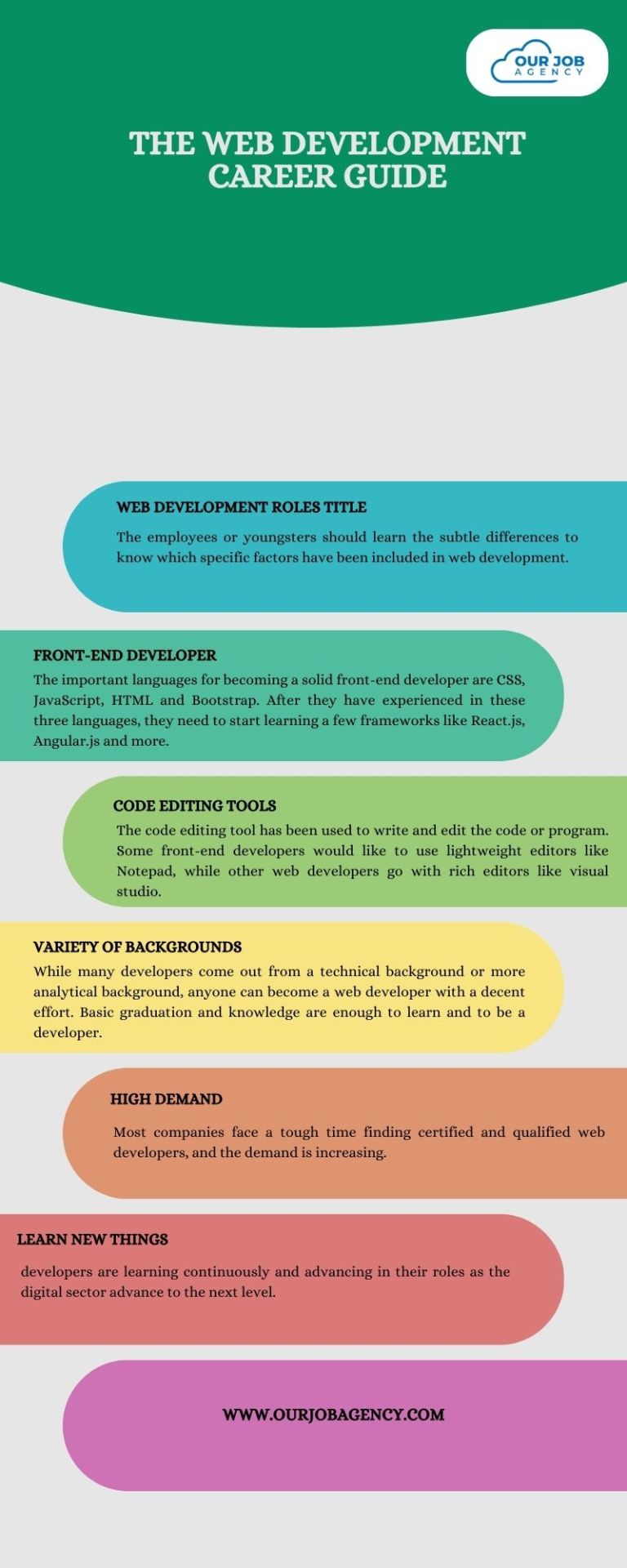
Technology plays a vital role in everyone’s daily lives, from the simplest forms of applications to the most creative inventions. Every application or software has been built by a web developer. In these present days, students and youngsters want to be web developers to make their careers way better.
#Web Development#Remote Work in Web Development#Web Development Certifications#Interview Tips for Web Developers#Salary Expectations in Web Development#Job Satisfaction in Web Development#Future of Web Development#Content Management Systems (CMS)#Website Optimization#Cross-browser Compatibility#Mobile Development#Web Security#APIs (Application Programming Interfaces)
0 notes
Text
The Role of Technology in Outsourcing Bookkeeping: How Assist Bay Uses Modern Tools for Seamless Integration

In today’s globalized economy, outsourcing bookkeeping services has become a strategic solution for businesses looking to streamline operations, reduce overhead costs, and improve efficiency. Particularly in the UK and the Caribbean, companies are increasingly outsourcing their accounting needs to offshore experts in India. At the heart of this transformation lies the role of technology, which has revolutionized the way businesses integrate with outsourced bookkeeping services. Assist Bay, a leader in providing outsourced bookkeeping solutions, is harnessing modern tools to make this process seamless, efficient, and transparent.
The Growing Trend of Bookkeeping Outsourcing
Outsourcing bookkeeping services is a growing trend, especially in the UK and the Caribbean, where businesses are constantly seeking ways to reduce operational costs while maintaining high-quality financial management. Many businesses in these regions, especially small to medium-sized enterprises (SMEs), are turning to offshore solutions like those provided by Assist Bay, which is based in India. Outsourcing bookkeeping not only allows companies to access skilled accounting professionals at a fraction of the cost but also ensures that businesses can focus on their core activities while maintaining financial accuracy and compliance with local tax laws.
Why India for Outsourcing Bookkeeping?
India has long been a go-to destination for outsourcing services due to its large pool of skilled professionals, a robust IT infrastructure, and cost-efficiency. Indian bookkeeping experts are well-versed in international accounting standards, including UK GAAP (Generally Accepted Accounting Principles) and Caribbean tax laws, making them a perfect fit for businesses in the UK and the Caribbean.
The Role of Technology in Bookkeeping Outsourcing
As the landscape of outsourcing evolves, so does the technology that supports it. At Assist Bay, modern tools play a crucial role in making bookkeeping outsourcing seamless. Here’s how technology is transforming the process.
Cloud-Based Bookkeeping Software
One of the biggest advancements in the bookkeeping industry has been the shift to cloud-based platforms. Tools like QuickBooks, Xero, and Zoho Books allow real-time access to financial data from anywhere in the world. This enables business owners in the UK and the Caribbean to collaborate effectively with their offshore bookkeeping teams in India. Cloud-based software ensures that all financial data is stored securely, and updates can be made in real-time, reducing the risk of errors. Whether it’s invoicing, payroll, or tax filing, cloud-based bookkeeping tools ensure that everything is up-to-date and accurate.
2. Automation of Repetitive Tasks
Another significant way technology has improved bookkeeping outsourcing is through automation. At Assist Bay, advanced automation tools are used to manage repetitive tasks such as data entry, transaction categorization, and reconciliation. This reduces human error, saves time, and ensures that the team can focus on more strategic tasks, like financial analysis and forecasting. By automating these routine tasks, businesses in the UK and Caribbean can rely on fast, accurate, and consistent bookkeeping services without the worry of manual errors creeping in.
3. Integration with Financial Systems
One of the key benefits of outsourcing bookkeeping to India is the seamless integration with a company’s existing financial systems. Modern tools allow for smooth integration with platforms like ERP systems, CRMs, and other financial applications. Assist Bay leverages APIs (Application Programming Interfaces) to connect various software tools, ensuring that data flows effortlessly between systems. This integration ensures that businesses don’t have to deal with fragmented information. They can access consolidated financial data, reports, and analytics from one central location, making decision-making more efficient and informed.
4. Data Security and Compliance
Data security and compliance are top concerns for businesses when outsourcing their bookkeeping. In the UK and the Caribbean, businesses need to ensure that their financial data is protected and compliant with local regulations. Assist Bay employs the latest encryption technologies to safeguard sensitive financial information, ensuring that only authorized personnel have access. Moreover, Assist Bay stays up-to-date with changes in tax laws and accounting standards, ensuring that all bookkeeping practices meet local regulatory requirements. For businesses in the UK, this means adhering to HMRC standards, while for companies in the Caribbean, it involves compliance with local tax laws, which can differ from one island to another.
5. Real-Time Collaboration and Communication Tools
Technology has also improved communication between outsourced bookkeeping teams and businesses. Assist Bay uses collaborative tools like Slack, Microsoft Teams, and Zoom to ensure constant communication and immediate resolution of any issues. This ensures that clients in the UK and the Caribbean are always in the loop and can easily discuss any concerns with their bookkeeping team. Real-time communication tools also allow for faster decision-making and better collaboration on financial reports and business strategies. As a result, businesses can stay agile and responsive in today’s competitive environment.
6. Data Analytics and Reporting
Gone are the days of manual ledger entry and paper-based reporting. With the help of modern tools, Assist Bay provides businesses in the UK and Caribbean with detailed financial analytics and real-time reports. By analysing financial data with AI-powered tools, Assist Bay helps businesses gain valuable insights into their spending habits, cash flow, and profitability. These reports can be customized to suit the specific needs of a business, giving stakeholders the information they need to make informed decisions. Whether it’s forecasting revenue, tracking expenses, or assessing tax liabilities, data-driven insights are now more accessible than ever before.
The Future of Bookkeeping Outsourcing
The future of bookkeeping outsourcing lies in the continued evolution of technology. As cloud computing, automation, and AI become more advanced, the role of technology in outsourcing will only grow. Assist Bay is at the forefront of this change, helping businesses in the UK and the Caribbean seamlessly integrate outsourced bookkeeping services with modern technology. By leveraging cutting-edge tools and maintaining a focus on security, accuracy, and compliance, Assist Bay ensures that businesses can confidently rely on outsourced bookkeeping services without compromising on quality. As the demand for outsourcing grows, businesses in the UK, Caribbean, and beyond will continue to benefit from the efficiency, cost savings, and strategic insights that modern technology offers. Outsourcing bookkeeping services to India is no longer just about saving costs — it’s about gaining a competitive advantage by leveraging the power of technology for smarter, more efficient financial management.
2 notes
·
View notes
Text
Introduction to SkillonIT Learning Hub- Empowering Rural Talent With World-Class IT Skills
SkillonIT provides IN-Demand IT courses, connecting Rural talent with rewarding IT skills through affordable, accessible and career-focused education. with Guaranteed pathways to internship and high paying jobs, start with us and step into Opportunities at top Tech-leading Companies. Skillonit Learning Hub, located in Buldhana, Maharashtra, is a leading institute dedicated to equipping individuals with cutting-edge technology skills. With a mission to bridge the digital divide, the institute provides high-quality education in various IT and professional development domains. Skillonit focuses on practical, industry-oriented training, ensuring students gain the expertise needed to thrive in today’s competitive job market. The hub is committed to empowering rural talent and shaping the next generation of skilled professionals.

Courses Offered Skillonit Learning Hub offers a diverse range of courses tailored to industry demands, enabling students to master both technical and professional skills.
Blockchain Development — Smart Contracts (Solidity, Rust, Web3.js, Hardhat) — Blockchain Protocols (Ethereum, Solana, Binance Smart Chain, Fantom) — Decentralized Applications (DApps) Development
Front-End Development — HTML, CSS, JavaScript — Frameworks: React.js, Vue.js, Angular — Responsive Web Design & UI Frameworks (Bootstrap, Tailwind CSS)
Back-End Development — Server-side Programming (Node.js, Python, PHP, Java, .NET) — Database Management (MySQL, MongoDB, Firebase, PostgreSQL) — API Development (RESTful APIs, GraphQL, WebSockets)
Full-Stack Development — Front-End + Back-End Integration — MERN Stack Development — Database, Deployment & DevOps Practice
Mobile App Development — Cross-Platform Development (Flutter, React Native)
Unity 3D Game Development — Game Mechanics & Physics — C# Programming for Game Development — Virtual Reality (VR) & Augmented Reality (AR) Integration
Professional UI/UX Design — User Interface Design (Adobe XD, Figma, Sketch) — User Experience Principles — Prototyping, Wireframing & Usability Testing
Professional Graphic Design — Adobe Photoshop, Illustrator, and CorelDraw — Branding & Logo Design — Digital Art & Visual Communication
Digital Marketing — SEO, SEM, and Social Media Marketing — Content Marketing & Copywriting — Google Ads, Facebook Ads & Analytics
Spoken English — Communication Skills & Public Speaking — Accent Training & Fluency Improvement
Personality Development — Business & Corporate Etiquette — Confidence Building & Interview Preparation — Leadership & Teamwork Skills
Location & Contact : Address : Chhatrapati Tower, Above Maratha Mahila Urban, 3rd Floor, Chikhali Road, Buldhana, Maharashtra, 443001.
Contact us
Conclusion : Skillonit Learning Hub is revolutionizing IT and professional education by making technology and essential career skills accessible to aspiring developers, designers, marketers, and professionals. With a strong emphasis on practical learning, industry exposure, and career opportunities, it stands as a beacon of growth for young talent in Buldhana and beyond. Whether you are looking to build a career in tech, marketing, design, or personal development, Skillonit provides the ideal platform to achieve your goals. Join Our Social Community
Skillonit #Education #ITCourses #Buldhana #Maharashtra #IT #Blockchain #Fullstack #Front-end #Back-end #MobileApp #Unity3d #UIUX #Graphicdesign #Digitalmarketing #SpokenEnglish #Personality #development
2 notes
·
View notes
Text
Shopify App Development: Unlocking The Full Potential of Your Online Store

What is Shopify App Development?
Shopify app development involves creating custom applications that integrate seamlessly with Shopify stores. These apps can help store owners automate processes, improve customer engagement, optimize marketing, and enhance store performance. Whether it’s a private app for internal use or a public app available on the Shopify App Store, the right solution can significantly impact business growth.
Types of Shopify Apps
Public Apps — Available on the Shopify App Store, these apps are accessible to all Shopify merchants.
Custom Apps — Designed for a specific store, these apps are built to address unique business requirements.
Private Apps — Used within a single store and not listed on the App Store, these are ideal for businesses needing specialized functionalities.
Benefits of Shopify App Development
Enhanced Store Functionality — Custom apps allow store owners to integrate additional features beyond Shopify’s default capabilities.
Automated Processes — Reduce manual work by automating tasks such as order management, customer segmentation, and inventory tracking.
Improved Customer Experience — Features like chatbots, personalized recommendations, and loyalty programs can enhance user engagement.
Seamless Integrations — Apps can connect Shopify stores with third-party platforms such as CRM, ERP, and email marketing tools.
Key Considerations for Shopify App Development
Understanding Business Needs — Identifying gaps in your store’s functionality is crucial for developing an app that solves real problems.
Choosing the Right Tech Stack — Shopify apps are commonly built using Shopify’s API, Node.js, React, and Liquid.
App Security — Since apps handle sensitive customer data, security measures like data encryption and authentication protocols are essential.
Scalability & Performance — Ensure that your app can handle increased traffic and grow alongside your business.
How OyeCommerz Can Help with Shopify App Development

Our Shopify App Development Services
Custom App Development — Creating bespoke Shopify apps that cater to your store’s unique needs.
API Integrations — Connecting Shopify with third-party tools for better workflow automation.
App Maintenance & Support — Continuous monitoring and updates to ensure optimal performance.
UI/UX Optimization — Designing user-friendly interfaces for an enhanced shopping experience.
Conclusion
Investing in Shopify app development can unlock limitless possibilities for your eCommerce store. By leveraging custom apps, businesses can optimize operations, improve customer satisfaction, and drive revenue growth. If you’re looking to develop a Shopify app that aligns perfectly with your business needs, get in touch with OyeCommerz today!
2 notes
·
View notes